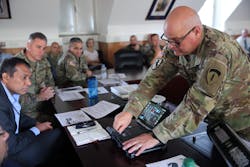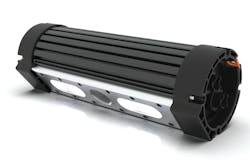The US Army has struck another deal with Scotland’s pureLiFi to outfit troops with Li-Fi, the light-based data communications technology that the Army says is harder for the enemy to hack than is radio-based Wi-Fi or cellular, and which could thus make for safer Army bases and field use.
The “multimillion dollar” supply agreement is similar to the $4.2 million accord struck in April between the two outfits. In both instances, Edinburgh-based pureLiFi is providing the US Army Europe and Africa with military-grade luminaires, known as access points, that modulate lightwaves in a manner that transmits data.
pureLiFi brands the luminaires as Kitefin.
Most of the details with the Army remain under wraps, although pureLiFi confirmed that the Army is procuring two versions of Kitefin, one for use in offices such as on a base, and another designed for rapid setup and takedown in the field, such as when troops might be moving around on tactical missions.
Li-Fi luminaires typically provide illumination while also transmitting data such as the Internet or private network access. As transmitters, they can communicate with devices such as tablets and laptops that are in their line of sight, and that are equipped with receivers that are either embedded or attached via USB dongles.
Very few laptop and device makers have yet embedded Li-Fi, which is one reason why the technology in general is enduring a prolonged commercial infancy.
In a notable exception to that general reluctance, Taiwanese ruggedized device maker Getac is embedding pureLiFi into tablets. It would seem logical that pureLiFi’s deal with the Army involves Getac. In a photo the company released in August this year, US Army Chief Warrant Officer 5 Andrew Foreman is using a Getac laptop while showing a demonstration version of Kitefin at the US Army Garrison Wiesbaden in Germany.
But pureLiFi would neither confirm nor deny that Getac devices are part of either the original $4.2M deal or the new multimillion dollar arrangement. Likewise, pureLiFi declined to divulge a more precise dollar figure for the second tranche, other than to describe it as multimillion dollar. It’s not clear whether the arrangement includes end-user devices such as Getac’s or others, or whether those would come via separate deals with device suppliers.
What is certain, however, is that the Army has come back for more Li-Fi, and that it values the technology for the security it provides. Compared to Wi-Fi and cellular, Li-Fi is more difficult to hack because it requires a direct line of sight with the luminaires.
The Army’s CW5 Foreman alluded to Li-Fi’s “low probability of detection, jamming, and intrusion,” in describing it as “an extremely survivable form of communications when in direct conflict with a near-peer adversary.”
Security is a benefit that convinced at least one other user, from a different walk of life — a conference business in Holland — to deploy Li-Fi, in that case from pureLiFi rival Signify.
Li-Fi’s proponents laud it for other benefits as well. The Army’s Foreman noted that it also helps to relieve the overcrowding in the radio spectrum that can cause radio-based services to slow down and become unreliable.
Li-Fi today generally uses LEDs as its light source, although its future could be in lasers. pureLiFi declined to say what light source is in the Kitefin system it is providing the Army.
MARK HALPER is a contributing editor for LEDs Magazine, and an energy, technology, and business journalist ([email protected]).
For up-to-the-minute LED and SSL updates, why not follow us on Twitter? You’ll find curated content and commentary, as well as information on industry events, webcasts, and surveys on our LinkedIn Company Page and our Facebook page.






